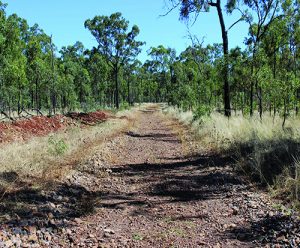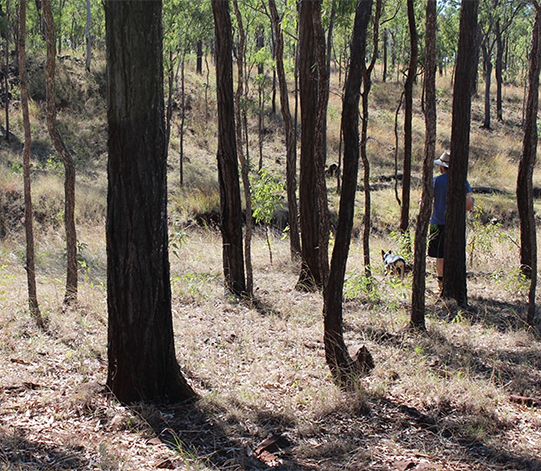
Story & Photos by Jenni Clark and Leigh Twine
My first experience of Lava Plains (North Queensland, Australia) was around 1985, when a local farmer allowed ‘friends of friends’ to wander around certain areas of his holdings, camp in a rough shelter used for putting out cattle lick in the summer, and randomly pick up bits of sapphire and anything else shiny wherever we saw it.
Hailing from Cairns (tropical locale considered the gateway to Australia’s Great Barrier Reef), our winter clothes consisted of tracksuits, jeans, and a spray jacket. We arrived at Lava Plains in July, full of enthusiasm for a weeks’ holiday spent alone in the bush with the promise of treasure to be found.
Venturing Into the Plains
The weather was clear, with bright, glorious sunshine and by nightfall, it was absolutely freezing. So much so we went to bed with the sun every night, wearing every garment we could fit on, under every blanket that we had bought, huddled together like a litter of puppies until the morning. The days were only marginally warmer and the only skin to see the light of day was on our hands; quite a shock to our tropical blood. It became one of those ‘remember the time’ family legends that we recall quite clearly some 30 years later, and not because of the gemstones which were scarce and poor quality. It is probably no surprise that it took us a long while to gather our courage to return for another go.
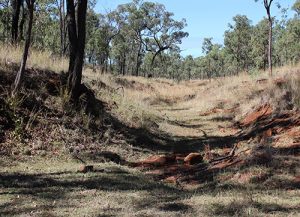
In 2016, with most of our party being new to fossicking (the Australian and New Zealand term for prospecting), we decided to try our luck with sapphires again and planned a long weekend trip to the Lava Plains fossicking area. We had done a lot of research into where to go and what to look for and felt we had a good chance of success this time around. What was unexpected on this particular weekend, was that working in a red soil area in the rain is a challenge in itself.
Not only was it cold and damp, but wet red soil becomes like glue on the bottom of everything — tyres (tires) shoes, buckets etc., and just builds up as you move, making you taller and your feet heavier with each step. After a couple of fruitless hours, we grudgingly admitted that Mother Nature had beaten us as the wash was impossible to dig or sieve. So we retreated, gemless, about 115km back to the Ravenshoe Highway to Innot Hot Springs to stay at the caravan park. It is fair to say that our second experience at Lava Plains wasn’t terribly encouraging either, and just as uncomfortable as the first, albeit for a different reason.
Focused Fossicking
However, not to pass up a weekend of fossicking, we headed to Mount Gibson, a few kilometers to the north of the caravan park, to look for topaz crystals on the hilltops of the old Patricia and Glittering Star mines. Mid-year in this area is really cold (by tropical standards), so the biggest drawcard of the Innot Hot Springs Caravan Park is the swimming pools that have heated water pumped from the local hot thermal spring. Being able to relax in the heated pools after a long day digging for topaz is just what the doctor ordered and it doesn’t get much better than that, sapphires or no sapphires.
Lava Plains is the general permission fossicking area on Lava Plains Station and the only known sapphire field in the district. Previously camping was permitted near the fossicking site, but the current landowner has disallowed camping for the usual reasons. Lava Plains is within the geological McBride Basalt Province. The area has a heavy covering of basalt rocks associated with the volcanic activity that formed the Undara Lava Tubes on Mt Surprise Station to the west. There has been considerable controversy over the geological formation of the sapphire-bearing areas in Australia, with theories that were proven in one field being soundly shot down on a neighboring field. The following excerpt from a lecture given in 2003 by Jim Elliott of Coolamon Pty Ltd, who extensively mined Aussie sapphire fields in Central and North Queensland, states:
“The conventional theory has it that the formation of the Central Queensland and the Lava Plains sapphire resources is the result of major extrusions or emissions from large volcanic sources and that the sapphire was subsequently transported by large river systems and deposited in the areas where it is currently mined today.
As a result of observations during some 20 years of mining on the Central Queensland Gemfields and five years on the Lava Plains field, I believe this theory to be totally incorrect.
I believe that the sapphire was produced from a large number of smaller vents which are located throughout the sapphire producing areas and that the sapphire never moves any significant distance from its point of origin at the surface.”
Understanding ‘Water-Worn’ Sapphire
He goes on to propose the ‘water-worn’ sapphire was actually created in that shape and appearance whilst being formed, rather than from the abrasive action on crystals traveling in streams or rivers for long periods of time. His theory makes a lot of logical sense. If you wish to research this matter further, consider: http://www.australiansapphire.com/sapphire_formation_theory.htm
The locality at the center of our research has been a prime cattle-raising area since
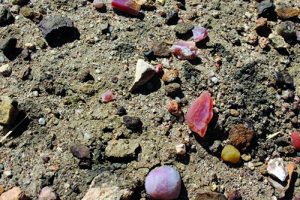
the mid-1800’s. The German explorer, Ludwig Leichardt, traveled through the region in 1846 and on reaching the top of the range to the east of the fossicking area, found a bountiful valley with abundant water and good grass. Leichardt named it Valley of Lagoons and today it is a cattle station of that name. He blazed a tree with his initials on the spot where he first saw the valley.
The author of a story in the Brisbane newspaper The Week wrote in 1908 “It (the tree) was burned down by a man who was not interested in the historical association.” Leichardt undertook this exploratory expedition from Brisbane, up the coast of Queensland, across Cape York and finally along the eastern coast of the Northern Territory ending at Port Essington, north of Darwin.
This remarkable trek, on foot and horseback, covered 4800 km of untouched wilderness and took 14 months. Government authorities had given up hope, believing the party to have perished on a route as the terrain is extreme, food in short supply along the way and the local Aboriginal people often hostile.
Locating the Lava Plains
Lava Plains is about 200 km southwest of Cairns via Atherton, on the Atherton Tablelands, then through Ravenshoe and Mt Garnet. After leaving Mt Garnet, travel 62 km on the Kennedy Developmental Road towards Hughenden where you will meet the Gulf Developmental Road turnoff heading west to Normanton and Karumba. There is an old gravel pit and a toilet block here where caravans often camp for a night or just stop for a cuppa. Continue on the Kennedy Developmental Road another 35 km to Lava Plains Station.
The fossicking area is on the left-hand side of the highway, marked only with a small sign in a clearing and I’m pretty sure we have overshot it on every visit. There is a parking area with a locked gate to stop vehicular access to the mine road, which is wide and well maintained (albeit very rocky and uneven to walk on), leading through the permitted fossicking area to a privately-owned mining lease. Entry to this lease is not permitted, especially after the lease owners lost most of their mining camp and equipment to serious theft.
The parking area has a turnstile that gives you enough room to squeeze yourself and a wheelbarrow through, and from there it is a 15-20 minute walk to the fossicking area of Wyandotte Creek.
Again, we decided to do a couple of days fossicking for sapphire at Lava Plains over the July long weekend in 2017. Being a good three-hour drive from home, we thought we would give Pinnarendi Station Stay and Cafe a go as our base camp. I contacted Nadine Atkinson on their Facebook page to book our sites, and as we had become a party of seven or eight vehicles who wanted to camp together, she was very obliging in giving us the larger sites so we could all fit comfortably.
Appealing Accommodations
The camping areas are so new that they were running cables for power and water infrastructure the day we arrived, with trenches and conduits having to be negotiated with care. There is a new amenities block that was yet not operational, but we all managed to share the one toilet/shower room with all the other campers/caravanners, which was a surprising number for a very new enterprise. The cafe offers coffee and morning tea/brunch, and a home-style hot meal every night if you book it in the morning. Saturday night is traditionally wood-fired sourdough pizzas, amazing gourmet varieties made while you watch, all you can eat for $20, and you can be sure some of the young men in our party got their money’s worth. Altogether, I would highly recommend Pinnarendi and we plan to stay there again.
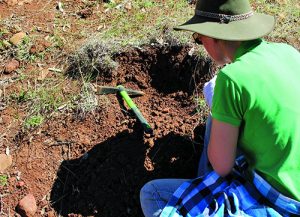
But, let’s get back to sapphires. We made the 45-minute drive from Pinnarendi towards Greenvale to Lava Plains on the first and third days of our trip, with the middle day being a trip to O’Briens’ Creek for topaz.
I am an avid ‘specker’ myself and find that I pick up as much colour as the die-hard dig-and-sieve brigade, which makes me a bit unpopular at times. Specking is the Aussie term for walking around a likely digging site with your eyes glued to the ground, picking up stones that have been overlooked by others or that have been exposed by heavy rain.
Gems like topaz, sapphire, agate and opal are often found by this method because they are shiny or colourful, and some surprisingly impressive stones are found on a regular basis.
Fossicking Process
It did appear as though the creek where we were digging had been commercially mined in places at various times, which means that finding the original gem-bearing wash is almost impossible and the majority of the good stones are gone.
It has been said that the mining machinery was designed to catch only the bigger stones and in theory, there should be gem-quality smaller stones that escaped the process remaining to be found by fossickers. The ground is very rocky, and the soil hard-packed and difficult to extract from between the boulders. Once in the sieve, the dark wash contains a lot of clay clods which must be broken apart for inspection, so it is by no means an easy field to work.
Having a supply of water to wash the gravel would have made the process much easier, but the creeks are all dry in the winter months and the fossicking area too inaccessible to consider carting water with us. All of our party are keen bush-campers and we just really enjoyed being out in the fresh air, sunshine, and bushland, with the hard yakka being part of the appeal.
Overall, we had an enjoyable five or six hours each visit, with all of us acquiring a spoonful of green or blue chips and bigger flawed bits, a deep cobalt blue being the Lava Plains predominant shade. Only one stone, found by my son-in-law, was a possible gem-quality cutter.
It is amazing how the trip walking back to the cars in the afternoon, although mostly downhill, always seems much more tedious than the one going uphill in the morning.
I had collected my haul of gems in a small glass jar. On our last day, as I was heaving my weary bones into our Landcruiser to leave, the jar dropped from my hand, landed neatly on the rockslider bar, smashed to smithereens in the long grass and I lost the lot. So if you ever visit Lava Plains, remember to have a quick speck around the carpark and you might be lucky.
Memories Created, Valuable Lessons Learned
I have always felt that fossicking is a game of chance, and like gambling, becomes
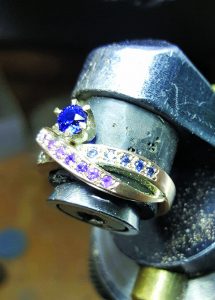
addictive. Being enthusiastic gem-hunters, I know we will return to Lava Plains for years to come, as ‘you just never know what you might find’ despite our previous experiences. Good stones have and still do, come from this field.
In mid-2016, as our families traveled through Mt. Surprise topaz-hunting, we stopped at the Gem Den, one of the local rock shops, where Leigh’s son bought a lovely blue Lava Plains faceted sapphire for the centre stone of the engagement ring for his future wife (Jenni’s daughter), thus Lava Plains has a lot of memories and good associations for us.
The Gem Den has a large range of beautiful local and imported, cut and rough gems of all sorts and quality ready-made jewelry for sale, well worth a look if you are passing through and you could get yourself a little, quality piece of Australia as a souvenir to remember your visit.


